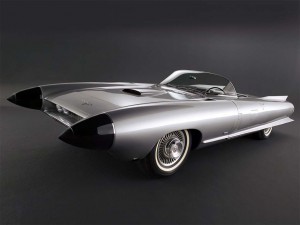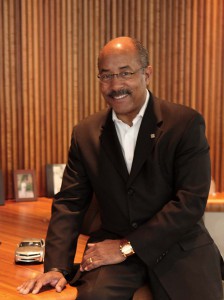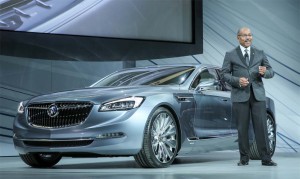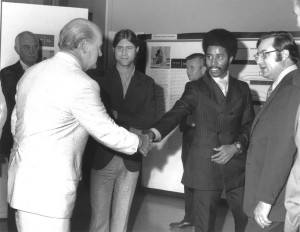He got his inspiration at an early age, just 10 and visiting the Philadelphia Auto Show. There, Ed Welburn got a look at a 1961 General Motors concept car, the jet-like Cadillac Cyclone. He was hooked and dreamed of becoming an automotive designer.
As an African-American growing up in the years before the Civil Rights Act was passed, it might have seemed the impossible dream, yet Welburn broke through all sorts of barriers in a 44-year career that will come to an end on July 1st as he cedes the reins as GM’s global design chief to 33-year veteran Michael Simcoe.
Over the past decade, Welburn nurtured a creative, inclusive and customer-focused culture among our designers that has strengthened our global brands,” said GM chairman and CEO Mary Barra.
(GM positioned to stay profitable in even a bad downturn. Click Here for the story.)
Welburn’s career has helped bridge several different eras at General Motors. When he joined the maker in 1972, the son of a Philadelphia auto mechanic reported to Bill Mitchell, only the second person to serve as GM design chief. It was still a time of unbridled optimism that the maker had captured so well in a range of post-War products.

The 1961 Cadillac Cyclone, the concept vehicle that inspired the 10-year-old son of a Philadelphia auto mechanic.
But change was sweeping across the country, and the auto industry. And as Mitchell retired, his successors struggled to deal with challenges including twin Mideast oil shocks and an aggressive assault by Japanese rivals like Toyota, Nissan and Honda. By the mid-1980s, many GM products had become the butt of jokes, a slide well framed by a cover of Fortune magazine showing an array of all but identical “badge engineered” sedans differentiated only by their brand logos.
By the turn of the new millennium, desperate GM managers brought in retired industry veteran Bob Lutz to run product planning. He had been a blunt critic, describing some of GM’s offerings as little more than “angry appliances.” In his new role as “car czar,” Lutz moved to shake things up, in 2003 appointing Welburn chief of design in the U.S.
Two years later, Welburn added the word “global” to his mandate, reflecting the fact that more and more of GM’s sales were coming from abroad. Under Welburn, meanwhile, a far-flung global network of design studios began to function as one. “GM design never sleeps,” he told TheDetroitBureau.com last year. Even if the lights were turned off in Detroit, styling studios in Germany or China would still be working.

Ed Welburn was not only the first African-American design chief but only the sixth man to head design for General Motors.
Welburn was only the sixth man to head GM’s styling operations – and the very first African-American in that post at a major automaker. It was an even tougher mandate considering he had to regain the success of flamboyant design leaders like Mitchell and Harley Earl, the latter credited with creating the very concept of automotive design back in the 1920s.
In contrast, Welburn “was a sharp dresser but he was a very human guy, never pushy,” said Ken Gross, a long-time automotive journalist and widely respected judge on the classic car circuit. Surprisingly humble, Welburn is known among his team for seldom raising his voice, “but he gets his message across quite clearly,” said one senior designer asking not to be quoted by name.
“Ed has the talent to encourage his designers to create cars that got people excited about GM again,” said Gross.
In many ways, Welburn has faced far more challenges than legendary design chiefs like Earl and Mitchell. Today, GM designers have to deal with issues like aerodynamics. Every new vehicle, car or truck, must be sculpted to reduce drag and improve mileage. New designs must wrap around “architectures” shared by a variety of different models – and meet various, often conflicting global regulations, as well as consumer desires and needs in places as far flung as Boston, Berlin and Beijing.
There have been a few misses, but far more solid hits, including two widely hailed concept vehicles for a brand not long ago written off for dead by many critics: the Buick Avenir sedan and Avista coupe.
(GM Tech Center, design dome, named to national register of historic places. Click Here for more.)
As is typically the case, industry observers expect Simcoe – who led the Avenir project — will eventually put his own stamp on GM’s design language, but the 65-year-old Welburn’s deft touch is not about to vanish. Vehicles he has been stewarding will continue to move through the production process for the next five years or more.
“Ed’s team turns out one award-winning product after another … and his strong bench will keep GM Design on top for years to come,” said Mark Reuss, the current head of global product development.
What’s perhaps the most important part of his legacy is the way Welburn helped make design essential again. Performance matters, and so does fuel economy. For younger buyers, things like infotainment are becoming critical differentiators when choosing between different products. But “design is what gets you to look at a vehicle in the first place,” former GM product chief Lutz is fond of saying.
And under Ed Welburn, General Motors has turned out plenty of products that have captured the eyes of consumers all over the world.
(Buick Avista, Avenir score big. But will they go into production? Click Here.)



